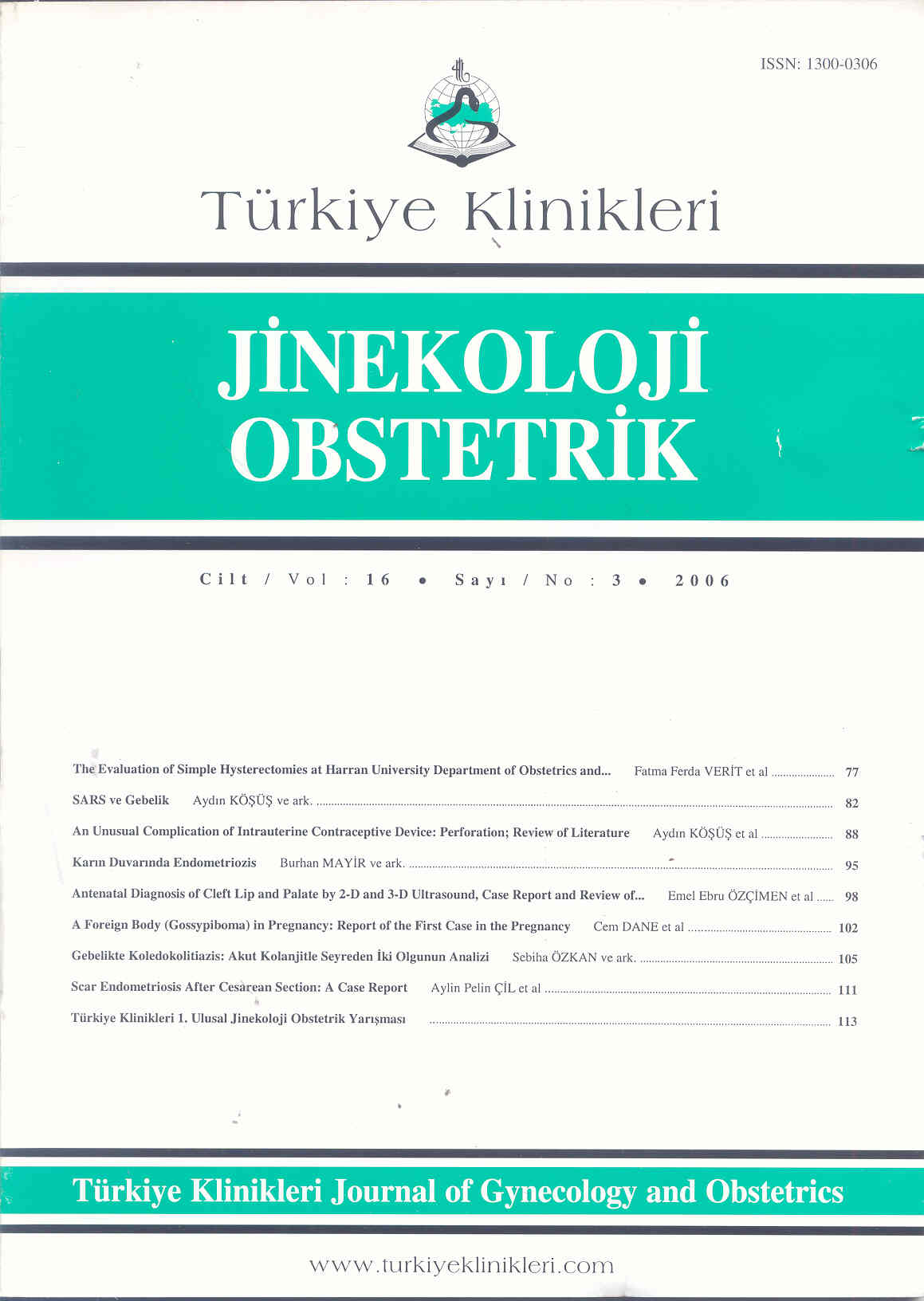Open Access
Peer Reviewed
ORIGINAL RESEARCH
2169 Viewed673 Downloaded
The Evaluation of Simple Hysterectomies at Harran University Department of Obstetrics and Gynecology
Harran Üniversitesi Tıp Fakültesi Kadın-Doğum Bölümünde Basit Histerektomi Olgularına Yaklaşım
Turkiye Klinikleri J Gynecol Obst. 2006;16(3):77-81
Article Language: TR
Copyright Ⓒ 2020 by Türkiye Klinikleri. This is an open access article under the CC BY-NC-ND license (http://creativecommons.org/licenses/by-nc-nd/4.0/)
ÖZET
Amaç: Uterusa sınırlı ve benign özelliklere sahip hastalıklardaki histerektomi operasyonlarına yaklaşım tercihimizi değerlendirmek. Gereç ve Yöntemler: Kliniğimizde Ocak 2002-Şubat 2005 tarihleri arasında yapılan 200 histerektominin verileri toplandı. Uterusa sınırlı, benign (leiomyoma, adenomyozis, anormal uterin kanama, karsinoma in situ veya prolapsus) ve 12 gebelik haftasından küçük uterusa sahip özellikleri gösteren hastalar çalışma kapsamına alındı. Histerektomi tipini belirlemedeki tercihimizi, günümüzdeki pratik uygulamalar ve kanıta dayalı tıpla kıyasladık. Hastanede kalış süresi ve komplikasyon oranları gibi kısa dönemdeki sonuçları da tartışıldı. Bulgular: Olguların %29'una vaginal histerektomi uygulandığı ve abdominal histerektominin vaginal histerektomiye oranının 2.4:1 olduğu tespit edildi. Abdominal histerektominin en sık endikasyonu leiomyom (%48.5), vaginal histerektominin ise prolapsus (%96.5) idi. Hastanede kalış süresi abdominal histerektomide vaginal histerektomiye kıyasla daha uzundu (sırasıyla; 6.1 ± 2.5 gün ve 4.4 ± 0.6 gün, p< 0.0001). Abdominal histerektomi operasyonlarında vaginallere göre daha sık komplikasyon oranlarına rastlandı (%44.3, %6.8; p< 0.0001). Sonuç: Abdominal histerektomi baskın olarak uygulanmaya devam edilen histerektomi tipi olmasına rağmen, pratikte konu ile ilgili tedavi protokollerinin uygulanması, kısa dönem etkileri iyi olan, hastanede kalış süresi az olan, daha düşük maliyet gibi avantajlara sahip olan vaginal histerektominin oranlarını artırabilir.
Amaç: Uterusa sınırlı ve benign özelliklere sahip hastalıklardaki histerektomi operasyonlarına yaklaşım tercihimizi değerlendirmek. Gereç ve Yöntemler: Kliniğimizde Ocak 2002-Şubat 2005 tarihleri arasında yapılan 200 histerektominin verileri toplandı. Uterusa sınırlı, benign (leiomyoma, adenomyozis, anormal uterin kanama, karsinoma in situ veya prolapsus) ve 12 gebelik haftasından küçük uterusa sahip özellikleri gösteren hastalar çalışma kapsamına alındı. Histerektomi tipini belirlemedeki tercihimizi, günümüzdeki pratik uygulamalar ve kanıta dayalı tıpla kıyasladık. Hastanede kalış süresi ve komplikasyon oranları gibi kısa dönemdeki sonuçları da tartışıldı. Bulgular: Olguların %29'una vaginal histerektomi uygulandığı ve abdominal histerektominin vaginal histerektomiye oranının 2.4:1 olduğu tespit edildi. Abdominal histerektominin en sık endikasyonu leiomyom (%48.5), vaginal histerektominin ise prolapsus (%96.5) idi. Hastanede kalış süresi abdominal histerektomide vaginal histerektomiye kıyasla daha uzundu (sırasıyla; 6.1 ± 2.5 gün ve 4.4 ± 0.6 gün, p< 0.0001). Abdominal histerektomi operasyonlarında vaginallere göre daha sık komplikasyon oranlarına rastlandı (%44.3, %6.8; p< 0.0001). Sonuç: Abdominal histerektomi baskın olarak uygulanmaya devam edilen histerektomi tipi olmasına rağmen, pratikte konu ile ilgili tedavi protokollerinin uygulanması, kısa dönem etkileri iyi olan, hastanede kalış süresi az olan, daha düşük maliyet gibi avantajlara sahip olan vaginal histerektominin oranlarını artırabilir.
ANAHTAR KELİMELER: Histerektomi tipi, benign hastalıklar, tedavi protokolleri, kısa dönemde görülen etkiler
ABSTRACT
Objective: To determine our preferred route of hysterectomy with benign diseases that is confined to uterus. Material and Methods: Data were collected from a total of 200 women who had hysterectomies in our clinic between January 2002 and February 2005. Patients were selected if they had abdominal or vaginal hysterectomies with benign diseases that were confined to uterus (leiomyoma, adenomyosis, abnormal uterine bleeding, cervical carcinoma in situ or prolapse) and if the uterus were smaller than 12 weeks of gestation. We compared our choice of approach with current clinical practice and evidence based medicine. Short term outcomes of hysterectomy like length of hospital stay and complication rates were also discussed. Results: Vaginal hysterectomy was performed in 29% of women and the ratio of abdominal to vaginal route was 2.4:1. The most common indication for abdominal hysterectomy was leiomyomas (48.5%) and for vaginal hysterectomy it was prolapse (96.5%). Length of hospital stay was longer after abdominal hysterectomies than vaginal hysterectomies (6.1 ± 2.5 days and 4.4 ± 0.6 days respectively, p< 0.0001). Higher complication rates were observed after abdominal hysterectomies than vaginal operations (44.3%, 6.8%; p< 0.0001). Conclusion: Although abdominal hysterectomy remains the predominant method of uterine removal, application of practice guidelines can increase the ratio of vaginal hysterectomies which has many advantages in regard to better short term outcomes, shorter length of hospital stay and overall cost of treatment.
Objective: To determine our preferred route of hysterectomy with benign diseases that is confined to uterus. Material and Methods: Data were collected from a total of 200 women who had hysterectomies in our clinic between January 2002 and February 2005. Patients were selected if they had abdominal or vaginal hysterectomies with benign diseases that were confined to uterus (leiomyoma, adenomyosis, abnormal uterine bleeding, cervical carcinoma in situ or prolapse) and if the uterus were smaller than 12 weeks of gestation. We compared our choice of approach with current clinical practice and evidence based medicine. Short term outcomes of hysterectomy like length of hospital stay and complication rates were also discussed. Results: Vaginal hysterectomy was performed in 29% of women and the ratio of abdominal to vaginal route was 2.4:1. The most common indication for abdominal hysterectomy was leiomyomas (48.5%) and for vaginal hysterectomy it was prolapse (96.5%). Length of hospital stay was longer after abdominal hysterectomies than vaginal hysterectomies (6.1 ± 2.5 days and 4.4 ± 0.6 days respectively, p< 0.0001). Higher complication rates were observed after abdominal hysterectomies than vaginal operations (44.3%, 6.8%; p< 0.0001). Conclusion: Although abdominal hysterectomy remains the predominant method of uterine removal, application of practice guidelines can increase the ratio of vaginal hysterectomies which has many advantages in regard to better short term outcomes, shorter length of hospital stay and overall cost of treatment.
MENU
POPULAR ARTICLES
MOST DOWNLOADED ARTICLES





This journal is licensed under a Creative Commons Attribution-NonCommercial-NoDerivatives 4.0 International License.











